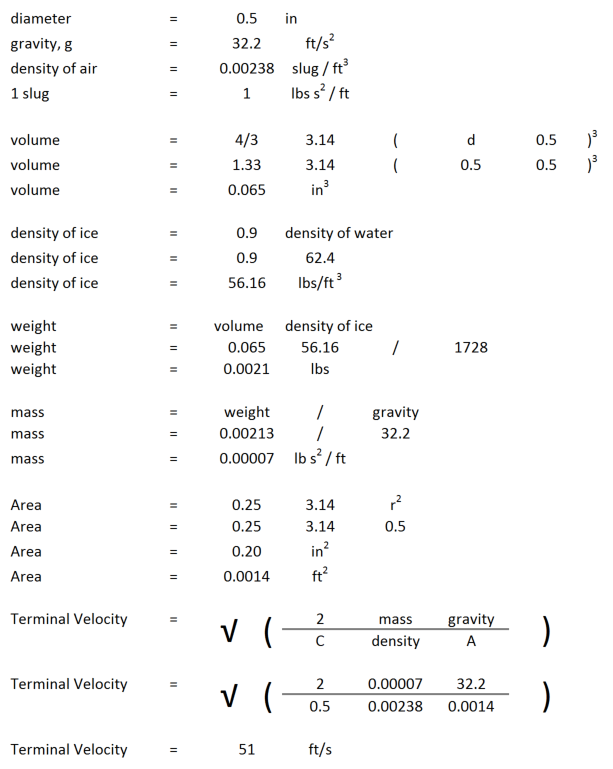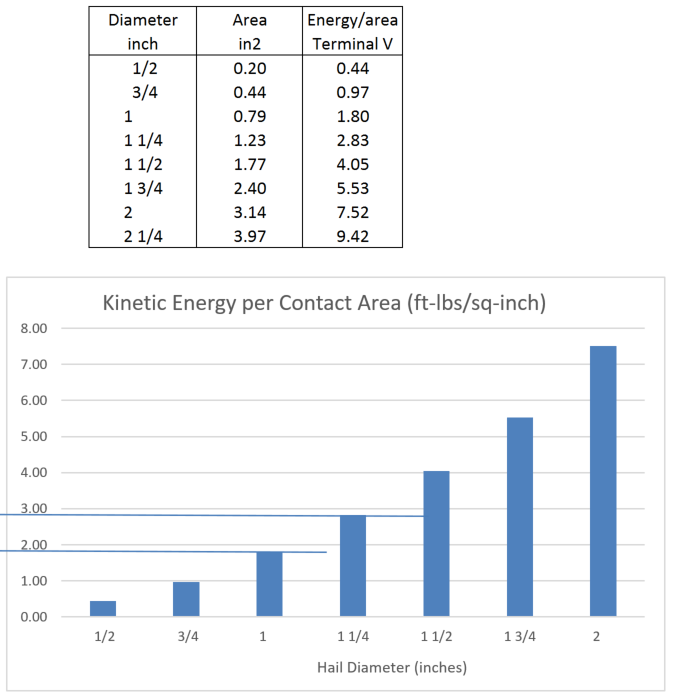Wind-Driven Hail Vs Hail without Wind
by Rick Abbott PE SE
Does wind significantly increase the damaging effect of hail? Is the intensity greater? To what degree? Does the damage look different?
Before studying these questions it is good to have an understanding of what researchers have done to identify "Threshold Hail" in the past.
Threshold Hail
Numerous studies have been conducted to identify what hail size causes damage to roofing materials. Researchers have created guns that shoot hail at specific speeds. The speeds have generally been fired at terminal velocities. The literature is in agreement. Hail that is on order of 1-1/4 diameter has been identified as the size of hail that starts to show damage to asphalt shingles assuming terminal velocities.
The question becomes, have the researches been using the correct velocity? Is wind driven hail faster?
The following table shows hail sizes and terminal velocities:


Kinetic Energy
The corresponding kinetic energies of hail can be calculated (E = ½ mass velocity^2). Comparisons have been made that show that the kinetic energy of hail increases exponentially with increase in diameter.
This is true; however, kinetic energy alone is not the best comparison to used.

Contact Area of an Impacting Object
The contact surface area is an important variable when evaluating impact forces. Hail transfers kinetic energy upon impact through a contact area. It makes logical sense to normalize the kinetic energy by diving it by the contact area of the ice ball. The energy of an ice ball is transferred to a surface over a contact surface that is proportional to its diameter. The smaller the contact area becomes the more likely damage will occur.
For example, if someone was allowed to punch someone in the arm with a closed fist being the contact area, it might cause a certain amount of damage such as a bruise. If that same person were to take the same swing, but hold a sharp blunt object, it might cause a puncture. The energy transferred would be that same, but the type of damage would be different because of the contact area. The graph below shows the energy of ice balls normalized by the approximate contact area.
If it is true that 1 ¼-inch hail at terminal velocity is the threshold hail that starts to show evidence of damage to asphalt shingles, then it could be said that an intensity of 2 or 3 ft-lbs per square inch might be the amount energy per square inch that is needed to cause damage.

Velocity Increase with Wind
What happens to ice when it falls to the earth. If no cross wind is present, the testing would match the real world. Hail would strike the surface at a terminal velocity, and the amount of energy transferred would be known if the hail size was known.
How does a cross wind effect the velocity of hail? This becomes a dynamic problem involving the free fall of projectiles through moving air.
The wind creates a horizontal load that pushes the ice ball in the direction of the wind. The wind is moving relative to the ground. If this were allowed to happen for a long period time eventually the ice would move through space at the same speed of the air. Upon striking an object on the ground, the velocity would have a vertical and a horizontal component.
It is reasonable to assume the horizontal velocity of the ice would be less that the wind speed. The drag force would remain the same but the direction might change. A conservative approach would be to assume a downward terminal velocity and a horizontal velocity equal to the wind. The resulting velocity would be a vector addition of the two.

Kinetic Energy of Wind Driven Hail
The table below shows the energy per square inch of ice balls with 0, 40, 60 and 80 mph cross winds. The mathematics show that 1/2-inch ice balls with 80 mph winds might have similar striking intensity as 1 1/4-inch ice at terminal velocity.

Summary
Often the size of hail at a specific location is not known, so this whole topic is usually immaterial.
Threshold hail size is an approximation. It is not an absolute. A person cannot simple state that there was no damage because a certain size hail stone was not present. There are too many variables.
Hail size still matters. The larger the hail the more likely damage has occurred.
Direction and cross wind are very significant in a hail investigation. The site inspection of a specific property with a good understanding of projectile impact is still the best means of evaluating hail damage claims.
Whither the hail is big or small, soft or hard, fast or slow, at an angle or straight down; it still encounters all sorts of items that can help gauge intensity. Dents, splatter marks, chipped paint, and clean-spot give evidence of direction and intensity.
No matter the intensity, hail still causes the same types of damage to asphalt shingles; granule loss, indentations, punctures, and fractures.
The following conditions have the same mathematical likelihood of causing damage:
- 1/2-inch hail with 80 mph wind
- 3/4-inch hail with 60 mph wind
- 1 -inch hail with 40 mph wind
- 1 1/4-inch hail in free fall without wind
If a strong driving wind is acknowledged to have propelled the hail in one direction then collateral evidence must support the hypothesis.